
January - February 2003
Vol. 14, No. 1 | Contents
by Ryan John
See
the ESPN broadcast on Friday, February 14:
2:00 pm EST
1:00 pm CST
12:00 noon MST
11:00 am PST
A fourth for Monchik
A first for Gudinas
Legends Tour
Sidelines
Pro-Am Doubles
St. Jude Wins
UM Interns
 Short Lived ... It's late
breaking news, but Sudsy Monchik will have to sit out for another season.
Here's what was reported on
his website ...
Short Lived ... It's late
breaking news, but Sudsy Monchik will have to sit out for another season.
Here's what was reported on
his website ...
Well, here I go again. I have had another curve ball thrown at me. On Feb. 5th I will be getting orthroscopic surgery on my right shoulder. Dr.Rokito who is the NY Mets official team orthopedics doctor will be performing the surgery at the Hospital for Bone and Joint Disease in Manhattan. He is the best in the business and deals with many professional athletes. I have some torn cartilage which has been diagnosed as a slap lesion. We are confident that after the surgery and rehab I will be 110% and play with a pain free swing! That is invaluable to me!
What does this mean? It means my season is done and I will not play anymore this year. I will be back and ready to go for the beginning of next season with NO PAIN!!! I will be going through an aggressive rehab over the next 5-6 months. The IRT is exciting and there are many awesome players and a great race for number 1 this year. I will be going to a few tournaments to support the tour and our great game of racquetball. I will also be in Houston for national singles supporting all of the amateurs. I do not have my rehab schedule yet but I will keep everyone informed of my progress ...
|
Guess
Who’s Back? After learning that he would have to sit out the rest of the season, Sudsy’s injury meant many things. Not only did he lose his bid to become the first man to repeat as U.S. OPEN champion, but he also lost his chance at becoming the first to capture six pro tour season titles. Despite the setback, he still managed to navigate to and around the 2001 U.S. OPEN in a wheelchair, sign autographs, and be “Sudsy”. And as a native New Yorker, he kept his perspective, “Things could be a lot worse,” he kept saying (referring to the events of 9-11, only weeks earlier). There were times, however, when you could read Sudsy’s face as he watched from the sidelines … “That should be me out there.” Instead it was Cliff Swain in the 2001 final, who went on to win his second title and later hold off a hot Jason Mannino at the end of the season to capture a previously elusive sixth pro tour title. Cliff, who everyone keeps trying to write off as being washed up, keeps proving the contrary. Whenever he hears “the aging Cliff Swain” or “Cliff can still hold his own with the new stars of the IRT” he just grits his teeth and takes care of business. He’s used to it by now — people have been trying to write him off for 10 years. This year it seemed only fitting that Monchik and Swain would meet in the finals once again for the Choice Hotels U.S. OPEN Racquetball Championships. They are, perhaps, the two greatest players to ever step onto a racquetball court. At the same time, they’re also two players that everyone had written off over and over again, especially this year. Two players that only know how to do one thing … win. |
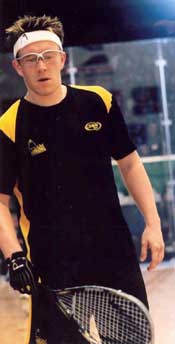 Excerpt ... beginning with the
Quarterfinal Round ...
Excerpt ... beginning with the
Quarterfinal Round ...
Sudsy vs. Jason is exciting if it’s only a pick-up game at a local club,
but on the sport’s grandest stage this match turns into a spectacle.
Playing to a capacity crowd, neither player held anything back, and the
stories retold for years to come won’t have any need for exaggeration.
Both players came out with heart and determination, making incredible
shots and keeping irretrievable balls in play, sending the crowd into
furious ovations after each rally. In the end, Sudsy came out on top of
his longtime friend in four spectacular games of 12-10, 11-9, 7-11, 11-3.
Just as exciting was the No.4 Jack Huczek vs. No.5 John Ellis battle on the show court. Huczek, who was defeated by Ellis at the 2000 Open, has since risen to the top-four on the IRT, was ready to show that his game has matured. Ellis came out firing in the first game and took it 11-8. Huczek wasn’t fazed and squeaked out a win in game two 12-10. He then preceded to dominate game three 11-4 and edged Ellis once again 12-10 to earn a spot in the semifinals.
No.7 Rocky Carson stepped up his game to give No.2 Kane Waselenchuk a run for his money. The first two games were tight with Kane coming out on top 12-10, 11-7. The third was just as close but it was Carson that mustered up the win 12-10 before falling in the fourth 11-8.
From the unusual mid-bracket berth, Swain continued his march toward the final with a straight game advance over Alvaro Beltran.
Semifinals
The semifinals were set and the match-ups mirrored each other, pitting
experience vs. youth. In the top half it was Monchik against Huczek, who
had made their rivalry clear, and vocal, earlier in the season. In front
of the enormous U.S. OPEN crowd, the pair was much more cordial and stuck
with their court skills to make bold statements.
Sudsy came out like a man possessed in the first game, taking it 11-4. Huczek came away with a win in game two 11-9, but there wasn’t enough momentum to carry him through. Sudsy seemed like a runaway freight train, gaining speed with each game, and passing round. He dismantled Huczek in the third and fourth games to close out the match 11-7, 11-6.
In the bottom half was the best lefthander ever, Swain, pitted against fellow southpaw and heir apparent, No.2 Kane Waselenchuk. They had put on great shows in past U.S. OPENs, but Swain, who hadn’t lost a game thus far, kept on track in eliminating Kane in three straight 11-9, 11-9, 11-7. Although the games were close and Kane was openly critical of referee Jason Thoerner in post-match comments, it wasn’t officiating that had decided the match.
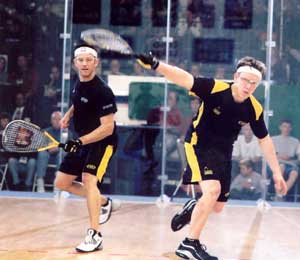 One more time …
One more time …
So, we arrive here again, with a Sudsy vs. Cliff battle. Their rivalry has
gone on for years (even penetrating the Sport’s Illustrated radar) but
this time it was a little different. For the first time in a long time,
both players had something to prove, not so much to themselves, but to all
of their detractors. Did it quiet those whispers that Sudsy wasn’t
motivated enough to come back from such an injury, or that Cliff is too
old to compete on the tour? Probably. They each proved, under the sport’s
brightest spotlight, that they are still the cream of the crop.
The first two games of the match were amazing, as Cliff built big leads in both, only to see Sudsy erase them meticulously to come out on top 12-10, 12-10. The third game was shaping up to be just as close, until Swain tweaked his back reaching for a shot. He hit the ball around a bit during a timeout to try and get himself back in order but the pain was obvious with each swing. Out of respect for his longtime rival, even Sudsy’s face showed concern, but if one thing is certain, it’s that there is no quit in Cliff Swain. They played out the last few points of the deciding third, but the damage was done, and Sudsy closed out the match 11-7.
“Everyone was wondering if I could come back from my foot (injury),” Sudsy said after the match. “How’s that for an answer?” he said holding his U.S. OPEN trophy, pointing towards the court.
| Cheryl Gudinas has been, hands down, the most dominant female racquetball player in the world for several years now. Even with growing parity in the LPRA ranks, she has always kept one or two steps ahead of everyone else. Through this reign Cheryl has won virtually every crown imaginable, with two world titles, four national singles titles, three national doubles titles, a Pan Am Games singles title, and twice she’s won seven tour stops in a row. But, one title has eluded her all of these years – the U.S. OPEN. At this year’s event, Cheryl didn’t want to make an issue out of the hole in her resume, but each year that she didn’t win in Memphis made the story grow bigger and bigger. How could the sports brightest star not shine on its grandest stage? “I’d like to win it just so people would quit talking about it,” she said early on, but everyone knew that there were other reasons. Cheryl is a champion and that’s what champions do – win. How could the sport’s most coveted prize slip through her grasp so often? |
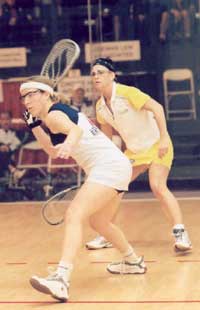 Excerpt ... beginning with the
Semifinal Round ...
Excerpt ... beginning with the
Semifinal Round ...
Gudinas realizes that Wachtel [shown at right, in foreground, against
Amy Foster] is capable of beating anyone, at any time that she steps onto the court. She found out firsthand at last year’s U.S. OPEN in the semifinals when Wachtel dashed her hopes, once again, of winning the sport’s most coveted crown. Now she found herself in the same position, but was determined not to let history repeat itself.
Wachtel, on the other hand, wouldn’t have minded a repeat of last year’s performance and she came out strong in the first game, only to fall short 12-10. Gudinas began to hit better shots as the match wore on and took the second 11-6. Wachtel kept the third game closer but Gudinas was on a mission that couldn’t be stopped and won 11-9.
Fenton had several upsets to her name by the time the semi’s rolled around, and looked to add No.2 seeded Rice to the list. But Rice had other plans and her play had continually gotten better as the tournament progressed. She continued that trend against Fenton, playing better with each game, and logged an 11-9, 11-6, 11-3 victory to move on (right).
Final
Just like the IRT, the women’s final featured two of the best to ever play the game. One had already won two U.S. OPEN titles, the other was still searching for her first. Last year Rice looked as though she had the tournament wrapped up after Gudinas was knocked out before the finals but Wachtel had thrown her a curve. This year, both Gudinas and Rice were on a mission and something had to give.
Gudinas has a winning record against Rice on tour, although, at times, their matches have been nail-biters. Gudinas already had enough pressure, and didn’t want to add more by getting off to a slow start.
Jackie won the toss, served first and moved ahead 2-0, while Cheryl dealt with some jitters and visibly grimaced after one loose shot gave Jackie an easy put away. But Cheryl gritted through nerves and evened the first game at 4-4, using a nice backhand half-lob along the side wall to force Jackie into playing defensively. Cheryl’s strategy was to slow down the more aggressive Rice, and it showed as she gained the upper hand in several ceiling-ball rallies to take the first game 11-5.
In back-and-forth action throughout game two, both players began missing shots they shouldn’t, perhaps due to it being the sixth match of a long tournament. After a tough avoidable call went against Jackie, she began volunteering more ceiling balls and conservative play — and falling into Cheryl’s hands as she built a commanding lead. At 4-10, Jackie ended a rally by hitting a great 39’ pinch winner, and followed it up with another nice pinch winner for 5-10, but it wasn’t enough. Cheryl claimed game two, 11-5, on a missed ceiling ball.
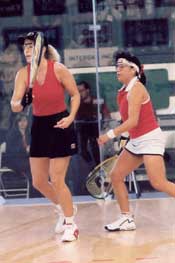 Despite winning the first two games easily, the monkey wasn’t quite off Cheryl’s back yet. Rice woke up to take a narrow 9-7 lead in the third, until Cheryl zoned in on three crisp passing shots to take the serve and tie it up at 9-9 before whiffing a setup off the back wall. A long ceiling ball rally ended with a Gudinas put away, and the possibility of a shutout.
Despite winning the first two games easily, the monkey wasn’t quite off Cheryl’s back yet. Rice woke up to take a narrow 9-7 lead in the third, until Cheryl zoned in on three crisp passing shots to take the serve and tie it up at 9-9 before whiffing a setup off the back wall. A long ceiling ball rally ended with a Gudinas put away, and the possibility of a shutout.
But while both had played well in rally, it was a tightly-wound Gudinas who pitched a lob serve out of play on the stadium courts lower sidewalls. Another quick side-out put Cheryl right back in the box … where she preceded to repeat the same, exact error! This time Rice took advantage of the service mis-cue and rattled off two points to take the game 11-9.
Some players would get rattled after dropping a game on crucial service errors, but not Gudinas. She came out in the fourth more determined than ever and took a quick 7-0 lead before Jackie tried to employ a strategy of picking on Cheryl’s less-aggressive forehand. But Rice’s passing shots to the right stayed up and her ceiling shots popped off the back wall nicely to give Cheryl a 10-1 lead, just as swiftly.
With championship point at hand Gudinas again began to get a little tight. Soon the score was 10-3, exchanges began to get testy and referee Brenda
Kyzer was compelled to intervene and ask the players to give each other a bit more room. After scrapping for points and still down 10-6, Rice was launching a comeback, but before she could kick it into high gear, Gudinas got the winner she needed to force a sideout and then closed out the match 11-6 for her first U.S. OPEN win.
“People kept telling me how big this was, now I am starting to see that it is,” said an elated Gudinas after the match. “I am just glad that it is over and I don’t have to talk about it (not winning the U.S. OPEN) anymore.”
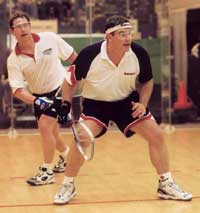 In its first full season, the Legends Tour made its U.S. OPEN debut on the stadium court in Memphis. The tour features some of the best to ever play the game in an invitation-only format. There were four players invited to play at the OPEN for a prize money purse of $5000. Of the four, all of them were considered "the best" at some point in their careers.
In its first full season, the Legends Tour made its U.S. OPEN debut on the stadium court in Memphis. The tour features some of the best to ever play the game in an invitation-only format. There were four players invited to play at the OPEN for a prize money purse of $5000. Of the four, all of them were considered "the best" at some point in their careers.Bret Harnett earned the top seed and, although he hasn't played much competitive racquetball since retiring from the pro tour, still looked to be in top shape. He faced Gregg Peck, who has stayed active in racquetball on the coaching side, leading the 2001-2002 U.S. Junior Team to another world title. Gregg held his own against the lefty, but Bret's power was too much throughout the 15-11, 15-13 match win.
Still considered by many to be the best to ever play, Marty Hogan was seeded second and faced yet another Peck [pictured L-R, above]... this time it was Dave. Both players have continued to compete in amateur age divisions and that competitiveness was evident as they battled it out just like "back in the day." Marty came out on top this time, but had to go extra innings 13-15, 15-5, 11-7.
The finals kicked off championship action Sunday on the stadium court. After dispensing of the Peck brothers a day earlier, Bret and Marty were ready to duke it out. The chatter was non-stop, as the two re-lived earlier days of trash-talking and fan exchange — even going so far as to ask the gallery to make calls that they felt the referee had overlooked. The games stayed close for beginning of each, before Bret pulled ahead to close out the match in straight games of 15-11, 15-12, and win the inaugural U.S. OPEN Legends Championship.
by Kevin Joyce
“It is the greatest event that you can play in. Last year I came for the first time. It’s all about watching the Michael Jordan’s of racquetball – and they are right here.” — Leo Cage (Memphis, TN)
“It is a great event. Just fantastic. We will be back next year.” — Juan Carlos (Cochabamba, Bolivia) Bolivian National Team Coach
“The staff is very organized and friendly. Come and watch some of the greatest racquetball on Earth. I finally got my friends to come and they really enjoyed it.” — Jerry Maxson (Hopkinsville, KY)
“There is not much competition in my age division (Men’s 70+) at home and I find many more people to play here. The matches are fantastic. I like Cliff Swain. He is my favorite – a very modest kind of guy. I’ll be back next year!” — Sean Reid (Las Vegas, NM) Sean lives part of the year in Ireland.
“We are very pleased with the facilities and the people. We’ll get more people to come next year. It is a great event.” — Genie Martin (Burlington, NC) Women’s 45+C/D contestant
“I have never seen professional racquetball and that was the main reason I wanted to be here. You can’t appreciate the athlete’s agility, speed and athleticism until you see it in person. I also visit with old friends that I have not seen in a long time and meet a lot of new people. You have the opportunity to rub shoulders with the best players in the world and they are accessible and part of the entire group right here in the bleachers. The world champions are all here.” — Mark Shupe (Cincinnati, OH) Kentucky State Racquetball Association President (1992-94)
“This is the coolest racquetball event ever. The players seem really big on the court!” — Matthew Brown (Winnipeg, Canada) Matt is the son of Canadian National Team Coach Ron Brown
“The competition is always very good; I like pulling for Sudsy. This is my first time in three years that I made a medal round (25+C/D). It is exciting.” — Steve Reisser (Murfreesboro, TN) Steve works at a Nissan plant in Smyrna, TN which has racquetball courts for employees.
by Ryan John
This year's U.S. OPEN kicked off, as always, with the annual Pro-Am doubles benefit fundraiser. Going into the event, the U.S. OPEN had donated over $84,000 in the past six years and set its goal at a cumulative total of $100,000 with gifts added in 2002 [a goal achieved ... see next
item].
The fundraiser paired 32 professional players with amateurs (who donate $250.00 per entrant to take part) in a single elimination format. In addition to sharing court time with the best players in the world, each amateur received an autographed racquet from their pro partner.
Winners of this year’s event were Cincinnati's Tom Curren and IRT No.1 Jason Mannino, who looks forward to playing in the benefit every year. “St. Jude is a wonderful charity to come out to support,” said Mannino. “It’s nice to be able to have so much fun and do something worthwhile at the same time.”
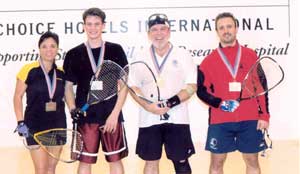 Through the drawn-out evening, the pair pulled out of the top half of a full draw of 32 with wins over Will Gumer/Tim Doyle, Steve Kowlabany/Mike Guidry, Twayne Howard/Jack Huczek, Cesar Carrillo/Brian Pointelin and Jake Brandyberry and current world doubles champion Jackie Rice in the final.
Through the drawn-out evening, the pair pulled out of the top half of a full draw of 32 with wins over Will Gumer/Tim Doyle, Steve Kowlabany/Mike Guidry, Twayne Howard/Jack Huczek, Cesar Carrillo/Brian Pointelin and Jake Brandyberry and current world doubles champion Jackie Rice in the final.
Pictured L-R: Rice, Brandyberry, Curren, Mannino.
The win this year makes it two in a row for Curren, who was partnered with Kane Waselenchuk last year. “I have been playing in this for six years now and have won the last two,” said Curren. “It (playing with a pro) forces an amateur player to play at a higher level. That and the fact that I have had two very good partners has helped me.”
Even though they were runner-ups, Jackie Rice (San Diego, Calif.) and Jake Brandyberry (Cleveland, Ohio) still enjoyed the event. “I had a great time playing with Jake,” said Rice, currently ranked No. 2 on the Ladies Professional Racquetball Association [LPRA] tour. “It’s not only fun but for a good cause.”
Donation Mark for St. Jude
by Dorothy Dee
The 2002 Choice Hotels U.S. OPEN Racquetball Championships raised $12,500 for the St. Jude Children’s Research Hospital — more than any other single U.S. OPEN and marking a $100,575 milestone in the event’s seven-year fundraising history for St. Jude’s.
The St. Jude Children’s Research Hospital, the U.S. OPEN’s designated charity, was founded by the late entertainer Danny Thomas in 1962. The St. Jude Children’s Research Hospital is one of the world’s premier centers for research and treatment of catastrophic diseases in children, primarily pediatric cancers.
“The great work done by St. Jude’s deserves our support and Choice Hotels is proud to play a small role in helping families who are facing very difficult challenges,” said Wayne W. Wielgus, senior vice president, marketing for Choice Hotels. “It is our goal to push this support even higher with the 2003 Choice Hotels U.S. OPEN Racquetball Championships.”
by E. Therese Pramick
For the fourth straight year, the U.S. OPEN continued its partnership with the University of Memphis chapter of the Public Relations Student Society of America (PRSSA). Ten UM interns were each assigned several pro players to “cover,” then developed media plans to create publicity in players’ hometowns. They interviewed the athletes and contacted their local media outlets to develop a professional rapport with sports editors and writers nationwide, as well as Canada and Mexico.
Throughout the tournament, interns drafted press releases after each match and sent them off to newspapers, television and radio stations. Part of the learning experience was in discovering that, after follow-up calls, racquetball was not a top priority for most media. But, through dedication and hard work, many found ways to “pitch” their athletes and succeed in securing coverage of their accomplishments, and for the event itself. TV news stations from across the country requested video feeds from local Memphis stations to air during their sports broadcasts and several newspapers asked for photography to accompany the press releases that they were picking up for reprint.
The interns lived and breathed racquetball for five days, usually working “standard hours” at the Racquet Club of Memphis that lasted well after midnight. Despite all of the hard work and long hours, most said it was well worth the effort.
“Though it was difficult at times, it was all worth it in the end,” said sophomore intern Ashley Perry. “It was an unbelievable learning experience and one I am looking forward to being involved with again next year.”
Most of the interns were unfamiliar with the sport ahead of time, but they immediately saw the appeal as the event began. Freshman intern Jessica Bearden even challenged the IRT’s No.10 player, Mike Green, to a late night match for fun. Green was able to squeak out the win but, most importantly, came off of the court uninjured, much to the surprise of onlookers.
While many of the students were new to the intern program, a few were repeaters. In fact, an intern tradition continued this year as No.3 ranked Cliff Swain gave his tournament sneakers to one of the returning interns, senior Adam Badrian.
Each intern claims to have learned a great deal from participating, whether they plan to go into a public relations field or not. They learned how to excel under pressure and deal with fickle media personnel. They honed their creative writing skills and perfected the art of interviewing players even after a disappointing loss.
“Getting a chance to participate in the racquetball internship was great,” said senior intern Amanda Jenkins. “I learned so much about what public relations practitioners actually do.”
“The partnership that we have established with the University of Memphis has become an invaluable part of Media Operations at the Choice Hotels U.S. OPEN. This year, I am proud to state that we experienced the best media coverage of any U.S. OPEN to date.” said USRA Media/PR manager Ryan John. “Most of this was due to the hard work and long hours put in by the interns. Even with finals approaching they remained dedicated, stayed up late with no compensation and sacrificed their free time. The job that they do is often overlooked and I wanted to personally thank each one of them.”
The USRA and U.S. OPEN staff would like to thank Dr. Rick Fischer at the University of Memphis Journalism Department for his continued support of the program and a very special thanks to Forsyth Kenworthy, a former intern, who continues to volunteer countless hours after working a full day at her real job! Without her help, year-round, the program would not run as smoothly.
Top | RacquetballMagazine.com | USRA.org
© United States Racquetball Association -- All Rights Reserved